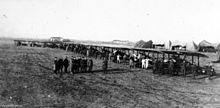|
Alan Rice-Oxley
Lieutenant Alan Rice-Oxley (1 July 1896 – 21 July 1961) was a British pilot during World War I. He became a flying ace in 1918, credited with six aerial victories.[1] Early lifeHe was born as Alan Rice Oxley in Kings Langley, Hertfordshire on 1 July 1896.[2] His parents were Edward Charles Rice Oxley (c. 1854 – 14 Mar 1927)[3] and Emily Armstrong[4] (1816 – 1883)[5] His parents had married in Shrewsbury on 14 January 1896. This was his father's second marriage, his father's first wife, Ann Eliza Hall[6] (c. 1857 – 1894) had borne 5 children and Rice was the middle child of three from the second marriage. Rice-Oxley was educated at Watford Grammar School for Boys, which he attended between January 1908 and July 1914.[7] Military career Rice-Oxley first served as a private in the 21st (County of London) Battalion, The London Regiment (1st Surrey Rifles), until 5 February 1915 when he was commissioned as a second lieutenant in the 4th Battalion, The King's (Shropshire Light Infantry).[8] He was seconded for duty with the Royal Flying Corps,[9] and appointed a flying officer on 10 September 1916.[10] He trained as a pilot and initially served with No. 15 Squadron in France, tasked with artillery-spotting and reconnaissance.[11] He was wounded in action during the Battle of the Somme in October 1916,[12] and after recuperating became a fighter pilot. He was promoted to lieutenant on 1 July 1917.[13] Subsequently, in 1918 he joined the Sopwith Camel equipped No. 45 Squadron on the Italian Front. He recorded his first victories in a combat on 12 July 1918. Piloting Camel D8240, he and Captain Cedric Howell engaged a formation of between ten and fifteen Austro-Hungarian aircraft in proximity to the town of Feltre. In the ensuing dogfight Rice-Oxley destroyed two of the enemy, and for his conduct in this action was awarded the Distinguished Flying Cross.[1] Over the course of the following three days, he destroyed another enemy aircraft and drove a further two down out of control.[11] On 16 August he was appointed a flight commander with the temporary rank of captain,[14] and achieved his sixth and final victory on 22 August.[11] Rice-Oxley was transferred to the RAF's unemployed list on 26 March 1919,[15] and relinquished his commission in the King's Shropshire Light Infantry on 30 September 1921.[16] Later lifeIn 1921 Rice-Oxley emigrated to North Borneo to join the armed constabulary there,[17] and was appointed as an officer of Class B in the following year, with the rank of captain.[18] His duties included showing visitors around and, in 1926, while motoring with the author Somerset Maugham, Rice-Oxley came across a 13-foot (4-metre) snake and killed it with his malacca cane.[19] He was appointed Superintendent of Police, Adjutant, and Superintendent of Prisons, in Jesselton in 1929.[20] His career continued apace and he attained the position of Commissioner of Police.[21] On 12 November 1936 he officially changed his name from Alan Rice Oxley to Alan Rice-Oxley by deed poll.[22] In early 1937 he married Valerie Helen Gardner.[23] Valerie was the widow of a fellow former RAF officer, Herbert Gardner, who had left the RAF in 1926 to move to the Federated Malay States, but was killed in Marseille in 1929.[24] After their marriage the coupled sailed in May 1937 from London on the P&O SS Ranchi; after the outbreak of the second World War the couple returned to England; later during the war Valerie remained in England when Rice-Oxley returned to North Borneo. From 1942–1945 Rice-Oxley was interned by the Japanese as a civilian internee at Batu Lintang camp near Kuching, Sarawak.[21] Post-war, he returned to Britain and was working as a dairy farmer at Knowle Farm, Uploders, Dorset, when he died on 21 July 1961.[25] He is buried in the churchyard of St. Mary Magdalene, Loders, Dorset.[26] Honours and awards
References
Bibliography
|
||||||||||||||||||||||||||